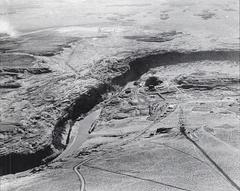
Elden Pueblo Visiting Hours, Tickets, and Guide to Marble Canyon Historical Sites in the United States
Date: 04/07/2025
Introduction: Exploring Elden Pueblo and Marble Canyon
Northern Arizona is home to two remarkable sites—Elden Pueblo and Marble Canyon—that showcase the intersection of ancient human history and stunning geological landscapes. Elden Pueblo, located near Flagstaff, is an archaeological site that offers deep insight into the Sinagua people’s culture and achievements. Just over a hundred miles away, Marble Canyon serves as the dramatic eastern gateway to the Grand Canyon, renowned for its breathtaking limestone walls, unique biodiversity, and enduring cultural significance. This guide provides comprehensive information on visiting hours, tickets, major attractions, practical tips, and the historical and cultural context for both destinations, ensuring a meaningful and well-prepared visit (Coconino National Forest; Arizona Natural History Association; visitmarblecanyon.com; grcahistory.org).
Table of Contents
- Introduction
- Elden Pueblo: History, Culture & Visitor Information
- Location and Setting
- Historical Background
- Archaeological Features & Significance
- Visiting Hours & Tickets
- Educational Programs & Public Engagement
- Site Features & What to See
- Practical Visitor Information
- Visitor Etiquette & Preservation
- Events & Nearby Attractions
- Cultural Sensitivity
- Frequently Asked Questions (FAQ)
- Marble Canyon: Natural Wonder & Visitor Guide
- Summary and Visitor Recommendations
- References
Elden Pueblo: History, Culture & Visitor Information
Location and Setting
Elden Pueblo (known in Hopi as Pasiwvi or Pavasioki) is located at the base of Mount Elden, about one mile north of the Flagstaff Mall on U.S. Highway 89 in Flagstaff, Arizona. The site is easily accessible and features parking near the entrance (Coconino National Forest).
Historical Background
Constructed and occupied by the Sinagua people between approximately 1070 and 1275 CE, Elden Pueblo was a thriving village consisting of 60–80 rooms built from stone and clay mortar. The Sinagua, whose name means “without water,” developed advanced agricultural and architectural strategies to thrive in this arid region. Archaeological discoveries, such as macaw skeletons from Mexico and shell jewelry from California, reveal the site’s role as a hub in extensive trade networks (Solo Trips and Tips; The Brain Chamber).
Archaeological Features & Significance
Elden Pueblo stands out for its complex architecture, including multi-room structures, a reconstructed ceremonial kiva, and terraced gardens that demonstrate ancient water management and farming practices. These features provide insight into the Sinagua’s daily life, social organization, and spiritual traditions, while ongoing research continues to inform our understanding of the region’s past, including the impact of nearby volcanic activity (Arizona Natural History Association; Tourist Secrets).
Visiting Hours & Tickets
- Hours: Elden Pueblo is open year-round with no set entrance hours. Daylight visits are highly recommended for safety and visibility.
- Admission: Free; no tickets are required (Solo Trips and Tips).
- Parking: Available near the site entrance.
Educational Programs & Public Engagement
Since 1978, Elden Pueblo has served as an educational site, offering field schools, public archaeology days, and hands-on workshops, often in partnership with the Coconino National Forest, Arizona Natural History Association, and Arizona Archaeological Society (Arizona Natural History Association). Programs include excavation and artifact analysis, with events such as the Primitive Technology Expo providing experiential learning opportunities (Arizona Natural History Association).
Site Features & What to See
Visitors can explore:
- Main Pueblo Complex: Stone and adobe multi-room dwellings.
- Reconstructed Kiva: Ceremonial room offering insight into Sinagua spiritual life.
- Artifacts: Pottery shards, stone tools, and other relics displayed along an interpretive trail (Tourist Secrets).
- Terraced Gardens: Demonstrations of ancient agricultural practices.
- Interpretive Trail: Self-guided with downloadable trail guide via QR code (Solo Trips and Tips).
Practical Visitor Information
- Facilities: No restrooms or visitor centers onsite—plan accordingly.
- Accessibility: The trail is relatively flat but not fully ADA-compliant; visitors with mobility concerns should be prepared for uneven terrain.
- COVID-19: Check the Coconino National Forest website for seasonal or health-related updates.
Visitor Etiquette & Preservation
- Do not disturb or remove artifacts.
- Stay on designated trails to protect fragile structures and research areas.
- Do not climb on walls or structures.
- Supervise children.
- Pack out all trash (Coconino National Forest).
Events & Nearby Attractions
Annual and seasonal events include mapping, excavation, and laboratory experiences. For group programs, email [email protected] or visit the Elden Pueblo Project Facebook page.
Nearby attractions:
- Wupatki National Monument: Large pueblos and a prehistoric ball court.
- Walnut Canyon National Monument: Cliff dwellings and scenic trails.
- Sunset Crater Volcano National Monument: Volcanic landscapes and cultural interpretation (Solo Trips and Tips).
Cultural Sensitivity
Elden Pueblo is a place of ancestral importance to the Hopi and other Indigenous peoples. Visitors are encouraged to respect the site’s spiritual significance and adhere to all guidelines (Solo Trips and Tips).
Frequently Asked Questions (FAQ)
What are the Elden Pueblo visiting hours?
Open year-round; daylight visits recommended.
Is there an admission fee?
No, admission is free.
Are guided tours available?
No regular tours, but educational programs and special events may include guided components.
Is Elden Pueblo wheelchair accessible?
The trail is relatively flat but not fully ADA-compliant.
For more information, visit the Coconino National Forest Elden Pueblo Heritage Site or the Arizona Natural History Association.
Marble Canyon: Natural Wonder & Visitor Guide
Geological Origins & Landscape
Marble Canyon is a striking geological corridor, carved by the Colorado River and bordered by polished limestone walls. Its formation began during the Laramide Orogeny, with tectonic uplift enabling the river to incise deep canyons over millions of years. The canyon extends over sixty miles from Lees Ferry to the confluence with the Little Colorado River, marking the start of the Grand Canyon (visitmarblecanyon.com).
Historical & Cultural Significance
The canyon’s isolation has preserved both natural and human history. Archaeological finds include 4,000-year-old split-twig figurines and ancient granaries, while federal protection since 1975 has ensured the preservation of its landscapes and ecosystems (grcahistory.org).
Gateway to the Grand Canyon
Marble Canyon is the recognized “gateway” to the Grand Canyon. At Lees Ferry—the only vehicle-accessible point for hundreds of miles—river expeditions begin, and the area’s infrastructure supports both adventure and exploration (visitmarblecanyon.com).
Biodiversity & Natural Highlights
The canyon supports rare species such as the endangered Humpback Chub and Kanab Ambersnail, as well as unique geological features like the Bridge of Sighs natural arch (grcahistory.org).
Activities & Visitor Experience
- River Rafting: Permits required; Lees Ferry is the launch point for Grand Canyon river trips. Both guided and private trips are available.
- Hiking: Trails range from easy rim walks to challenging descents into side canyons. Cathedral Wash and Spencer Trail are popular choices.
- Wildlife Viewing & Photography: Opportunities abound for birdwatching, spotting bighorn sheep, and capturing dramatic canyon vistas.
- Educational Programs: Ranger-led activities and interpretive exhibits are offered seasonally.
Practical Visitor Information
- Hours: Marble Canyon is open year-round. Lees Ferry facilities are generally open from 8:00 AM to 5:00 PM; check for seasonal changes (National Park Service).
- Admission: Included with Grand Canyon National Park entry; separate permits needed for river trips and some campgrounds.
- Accessibility: Some facilities at Lees Ferry are accessible, but most terrain is rugged.
- Accommodations: Limited lodging and campgrounds nearby; additional options in Page and Kanab.
- Safety: Bring sufficient water, sun protection, and navigation tools. Cell service is unreliable.
Conservation & Stewardship
Marble Canyon is protected within Grand Canyon National Park. Visitors are urged to follow Leave No Trace principles and respect both natural and cultural resources. The canyon’s preservation is the result of ongoing conservation efforts (grcahistory.org).
Notable Landmarks & Points of Interest
- Lees Ferry: Historic river crossing and launch site.
- Nankoweap Granaries: Ancient storage sites accessible by river or strenuous hike.
- Bridge of Sighs: Natural arch viewable from the river.
- Paria River Confluence: Ecologically rich area.
Frequently Asked Questions (FAQ)
What are Marble Canyon’s visiting hours?
Open year-round; Lees Ferry facilities typically 8:00 AM–5:00 PM.
Do I need permits for river trips?
Yes; apply in advance through the National Park Service.
Is Marble Canyon accessible for people with disabilities?
Some Lees Ferry facilities are accessible; most terrain is rugged.
Are pets allowed?
Permitted in developed areas (on leash), but not on most trails or river trips.
What should I bring?
Water, sun protection, sturdy shoes, and navigation aids. Prepare for variable weather and limited services.
For more details, visit the National Park Service Marble Canyon page.
Summary and Visitor Recommendations
Elden Pueblo and Marble Canyon together offer a tapestry of ancient human achievement and breathtaking natural wonders. Elden Pueblo invites exploration of Sinagua archaeology and Hopi heritage, while Marble Canyon presents dramatic landscapes and unparalleled outdoor adventure at the threshold of the Grand Canyon. Both sites are accessible, educational, and best experienced with respect for their cultural and environmental significance. Utilize official resources, download the Audiala app for guided tours, and engage with local educational programs to enhance your visit and support ongoing stewardship of these irreplaceable landmarks (Arizona Natural History Association; Coconino National Forest; visitmarblecanyon.com; grcahistory.org).




